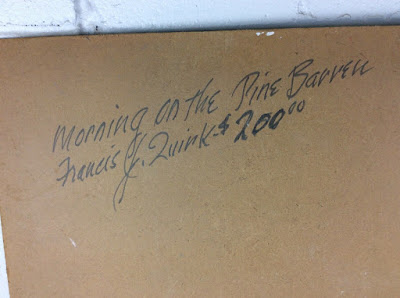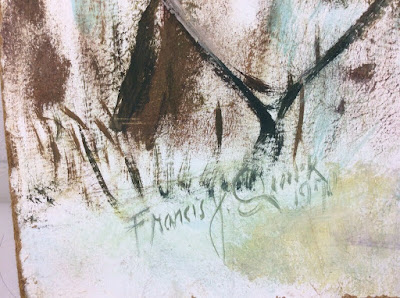Through a generous and thoughtful collector of Francis Quirk's art we have obtained a program from a Lehigh University exhibition of his paintings. The year is not provided, however we now know that the year was 1969 as an attendee at the event who purchased a painting was able to confirm it by matching the weekday with the calendar. One data point is that the painting on the cover of the exhibition catalog entered the collection in Georgia in 1971.
 |
| Cover of Francis J. Quirk Exhibition Flyer |
In this post, we are attempting to try to virtually recreate the exhibition, by providing as many paintings as we can. It is a work in progress that we will add to as we gain images. But before we continue, let us first comment on the exhibition and the paintings highlighted in the pamphlet.
Quirk had been the main pillar of arts at Lehigh University before his retirement and conversion to Professor Emeritus in 1969. In his 19 years at the school he scheduled numerous cutting edge exhibitions, fostered the careers of many artists and championed the arts in the region. This exhibition continues that tradition of pushing the envelope and including works from his classic interests: portraiture, maritime and nature.
Quirk had been the main pillar of arts at Lehigh University before his retirement and conversion to Professor Emeritus in 1969. In his 19 years at the school he scheduled numerous cutting edge exhibitions, fostered the careers of many artists and championed the arts in the region. This exhibition continues that tradition of pushing the envelope and including works from his classic interests: portraiture, maritime and nature.
Placing the portrait of Queenie Williams on the cover was a daring move and illustrates Quirk's ability to push the boundaries of his times. At the time of this writing, almost 50 years later, many US art museums have realized their woeful lack of women of color in their collections. In 1970, putting this painting up front at an exhibition at Lehigh University in a predominantly Caucasian community clearly made a statement. While it seems hard to believe, at this time, Bruce Springsteen was not welcome to perform at certain U.S. colleges because his iconic saxophone player Clarence Clemons was an African American. This fine work now resides in the collection of the Georgia Museum of Art.
 |
| Inside Cover of Francis J. Quirk Exhibition Flyer |
It also contains maritime works with several painting of sailboats. Quirk thoroughly enjoyed painting boats and on his retirement looked forward to painting many of them at his summer home in Kinney Shores, Maine.
 |
| Painting Listing of Francis J. Quirk Exhibition Flyer |
One of the hostesses for the evening was his wife, Anna. We believe she is in the photo below, but do not think this is from this particular exhibition.
 |
| Francis Quirk discusses a painting with Anna J. Quirk and another gentlemen. |
 |
| Francis J. Quirk Exhibition Flyer back cover |
Below are the images that we have assembled as of this date and a few comments about them.
#2 Shrimper Early Morning Canton Museum of Art
 |
| Shrimper Early Morning Image courtesy of Canton Museum of Art |
#4 The Soloist Queenie Williams
 |
| The Soloist (Queenie Williams) by Francis J. Quirk Image courtesy of the Georgia Museum of Art |
#11 Man's Island
 |
| Man's Island by Francis J. Quirk photo reproduced from exhibition pamphlet |
#14 Marconis and Gaff
 |
| Marconis and Gaff photo reproduced from exhibition pamphlet |
#16 Patterns --- Sloops This delightful work was highlighted earlier in a brief post as the collector/owner shared the image with us. After seeing this post, she graciously informed us that she had purchased it at the event, which was held in 1969. An earlier iteration of this post had the year as 1970.
 |
| Patterns --- Slooops by Francis J. Quirk |
#37 The Artist Note that there is another self-portrait in the collection at the University of Notre Dame's Snite Gallery from approximately the same period. They will not authorize reproductions, so it can not be included. However, if you are in South Bend, you can stop by the Snite and ask to see it. We are not fully certain whether this image or the Notre Dame image belongs here.
 |
| The Artist self portrait by Francis J. Quirk. |
#38 Island Trees #1
 |
| Add caption |
#38 Island Trees #3
#42 Dr. J. Rutzky We do not have an image of this painting at the moment. However, we have reached out to Dr. Rutzky's family to see if they still have the work. If so, we will update this post.





































